MAGINE a time when people only dreamed ot flying, when the sight of a jet streaking across the sky would have been astounding, and the idea ol launching a rocket into space too fantastic to comprehend. You may be surprised to learn that time was not very long ago. It is possible that someone you know was born before airliners and jets even existed.
The stories you are about to read — and the amazing pictures you will see — capture the wonder and excitement of a history that is still unfolding. At the dawn of the 20th century, the first powered aircraft took to the skies. By the century’s end, the International Space Station was on its way to becoming a reality. In the first years of the new millennium, engineers are developing reusable space vehicles, designing airplanes that wi 11 fly at fi ve times the speed ol sound and exploring a human mission to Maes.
The pioneers of flight paved the way for a future idled with adventure and achievement, a fact demonstrated every day at the Smithsonian s National Air and Space Museum, hilled with history-making aircraft anti spacecraft, the Museum brings to life the work ol the inventors and scientists who created them, portrays the courageous av iators and astronauts who flew them and explains how our world is changing because of the progress in aviation and space exploration. The Smithsonian National Ліг anh Space Museum Book of Flight celebrates the Museum’s famous collection and reveals highlights ot its many exhibitions.
In the following pages, for example, you will be introduced to two brothers — \ ilbur and Orville Wright. As children they made and flew kites. \ hen they got older they designed and built bicycles. Soon they were able to put their mechaniCctl skills to use in achieving their dream: On December 17, 1905, on a windswept beach near Kitty Hawk, North Carolina, they flew the
first powered airplane into the history books.
Mill ions of people come to see the original Wright Flyer at the National Air and Space Museum every year.
People also come to the Museum to see other early airplanes like the Spirit of St. Louis. In it, a 25-year-old airmail pilot named Charles Lindbergh flew nonstop from New York to Paris in 1927, a 33’L hour flight that six other pilots died trying to achieve. Five years later, Amelia Farhart became the first woman pilot to fly solo across the Atlantic. Her bright red Lockheed Vega sits in the Museum’s Pioneers of Flight gallery.
Aviation’s powerful influence on world history is shown in exhibits that describe military activities over the decades. In the Book ot Flight, you’ll learn all about famous battles and discover how the first bombers and fighter planes worked. You will meet heroes like America’s World War 1 flying ace, Captain Eddie Rickenbacker, as well as other military legends such as Baron Manfred von Richthofen, also known as the "Red Baron.” (Do you know what lamous cartoon character is still waging war on the Red Baron? Look for the answer in one of the book s many Fun Facts.)
The courage of V odd V аг II fliers is shown in the inspiring story of the luskegee Airmen, the first African-American fighter pilots. This skilled and daring group fought against great odds to defend our country’ on two fronts — against the enemy in Europe and against racial prejudice in this country.
By the middle ot the 20th century, aircraft designers were focusing on speed. Suspended
 * Touch the Moon
* Touch the Moon
A young visitor at the National Air and Space Museum delights in touching the Moonrock, collected by Apollo 17 astronauts in 1972.The Museum is one of only two places on Earth where visitors can touch lunar rock. The other is Johnson Space Center in Houston, Texas.
▼ Hands-on Learning
In the Hail of Air Transportation, interpreter Katherine Tuow helps young visitors compare early passenger aviation with modern travel. She shows them a model DC-3 airliner and lets them try on early and recent pilot uniforms from a "Discovery Cart."

 from the Museum’s ceiling is the Bell X-l, a bright orange, bullet-shaped plane equipped with a rocket engine. In 1947 an American test pilot named Chuck Yeager accelerated it to 700 miles per hour to break the sound barrier for the first time.
from the Museum’s ceiling is the Bell X-l, a bright orange, bullet-shaped plane equipped with a rocket engine. In 1947 an American test pilot named Chuck Yeager accelerated it to 700 miles per hour to break the sound barrier for the first time.
It was not long after this milestone that the race to conquer space was on. In 1962 America’s effort to orbit the earth was successful. Astronaut John Glenn ’s Mercury Friaubbip 7 capsule is now on display in the Milestones of Flight gallery. Other Museum exhibits trace the expansion and progress of space exploration, as well as the science and technology behind the breakthroughs. H undreds of displays and artifacts — rockets, capsules, tools, vehicles, equipment, space suits, even space food — tell this continuing story.
One of the National Air and Space. Museum’s most popular displays features a rock from the Moon. This four-billion-year-old sample was taken from the lunar surface in 1972 by astronauts participating in the Apollo 1/ mission.
Since it opened on the National Mall in Washington, D. C. in 1976, the Air and Space Museum has welcomed more than 212 million people. The world’s most visited museum.

it is the length of three city blocks and has exhibitions on two floors. Amazingly, however, there is room tor only 10 percent of the national collection of aviation and space artifacts.
For this reason, the museum is constructing a new building that will be large enough to display an additional 80 percent of the collection.
Jn December 2003, we will celebrate the 100th anniversary of Wilbur and Orville Wright’s historic flight will be celebrated by opening the Steven F. Udvar-Hazy Center at Washington Dulles International Airport. This amazing facility will be ten stories high and three football fields long. It is named for the man who provided a major contribution to help construct it.
lsitors to the Udvar-Hazy Center will be able to walk among artifacts on the floor and also along elevated “skyways” to view hanging aircraft. Many engines, rockets, satellites, helicopters, airliners and experimental flying machines will be displayed for the first time in a museum setting. Over 200 aircraft and 135 spacecraft will be on view, including the prototype space shuttle Enterprise and the SR-71 Blackbird, the world’s fastest airplane.
There will be an observation tower overlooking Dulles air traffic, plus restaurants
and shops. Visitors will also be able to enjoy exciting movies in a large-screen theater, and ride thrilling simulators.
As the Director of the National Air and Space Museum, I feel I am one of the luckiest men on the planet. I not only have the chance to be in the world’s most fascinating museum every day, I also know what it is like to be in the cockpit, having served for many years as a Marine Corps pilot. In addition, I was privileged to continue my flying and play a role in the space program by working at the National Aeronautics and Space Administration.
Although my career has included many roles, the one I care most about is being a father and grandfather. It is for this reason that I want to preserve and share the magnificent history and technology of aviation and space explorat ion with you and others.
Over the past century, we have come a long way. But lor future generations, the best is yet to come.
General John R. “Jack ” Dailey, USAIC (Ret)
Director
R ational Air ojw Space Museшп






!NCE ancient times, people have dreamed of living: like birds. In Greek myths, heroes made wings to fly. In Persian legends, people zoomed through the sky on magic carpets. Г he ancient Chinese invented kites, and some reportedly carried humans aloft. During the Middle Ages, many people tried to fly. Some strapped on wings of cloth or feathers and jumped off towers or cliffs. Yet nothing worked, and many died.
Then in 1783, two French brothers,
Joseph and Etienne. Montgolfier, invented the hot-air balloon. \ orking in their family’s paper factory’, they noticed that paper put on a fire was lifted up the chimney. 1 hey filled a large cloth-and-paper bag with hot air from a fire. I’he hot air made the balloon lighter than air, and it rose over Pans, carrying two noblemen. This was the first recorded human flight.
In 1804, Englishman George Cayley invented the first heavier-than-air craft, a model glider. Later piloted by German Otto I. ilienthal, gliders we re the ancestors of the modern airplane.
4 Sir George Cayley (1773-1857)
Often caked the "Father of Aeronautics," Sir George Cayley first establ shed the scientific principles of heavier-than-a’r fl:ght. Studying b rds, he understood that wings create a force called’lift." He also understood propulsion and control in fi ght and he predicted powered aircraft in the future. He first built a five-toot – long model glider based on a kite. Later, in 1853, he built a large glider that carr e: his unw lling coachman a short way. Afterward, tne frightened coachman resigned, saying "I was hired to drive, not fly!"
|
< Up, Up, and Away
On November 21,1783, Jean Francois Pilatre de Rozier and the Marquis d’ Arlandes took off in a Montgolfier balloon before astonished Parisians.
Jhe brightly colored balloon rose 300 feet and floated for about 5 miles over Paris.
|
|

Flight Control
Lilienthal steers his glider by swinging his legs and shifting his weight. This method of control was limited and dangerous.
Gliding Pioneer
Jumping into the wind, Otto Lilienthal sails through the air in a hang glider as spectators watch. Lilienthal tested many of his glider designs by leaping off a custom-made, cone-shaped hill near Berlin. He flew over 2,500 flights, up to 64 feet high and nearly a quarter mile long.
Otto Lilienthal (18^9-1896)
Otto Lilienthal was a German engineer who studied bird flight and was the first person to actively pilot, or control, a glider. Between 1891 and 1896, he built and flew 18 glider designs of lightweight cotton, willow, and bamboo. Unpowered, they glided on winds and updrafts, the same way birds soar. Lilienthal scientifically recorded his research, which greatly helped later inventors. A fearless flier, he finally crashed when he lost control in a gust of wind. He died the next day. His last words were:"Sacrifices must be made."
High-Flying Act
Ballooning and gliding became exciting spectator sports in the 1800s. This 19th-century German poster ^
features a young woman л
balloonist and aerial acrobat НІ
named K. Paulus. Шш
◄ Go Fly a Kite
Some 19th-century thinkers returned to the idea of kites as ways to carry people aloft. Here, Alexander Graham Bell, inventor of the telephone, explains his idea fora large kite made up of many triangular surfaces.















 Gossamer Albatross
Gossamer Albatross ROCKETS have been around For centuries. The
ROCKETS have been around For centuries. The


 THE space age began with the launch of Sputnik in 1957. In 1959, the United States began testing a new aircraft. Sleek, streamlined, and rocket- powered, the North American X-15 was the fastest, highest-flying airplane ever built. Its purpose was to fly to the end of the atmosphere and up into the edge of space. It gathered information that was later of great use to engineers planning a U. S. space program.
THE space age began with the launch of Sputnik in 1957. In 1959, the United States began testing a new aircraft. Sleek, streamlined, and rocket- powered, the North American X-15 was the fastest, highest-flying airplane ever built. Its purpose was to fly to the end of the atmosphere and up into the edge of space. It gathered information that was later of great use to engineers planning a U. S. space program. Another experimental vehicle was a wingless aircraft called a "lifting body." Launched in mid-air from a B-52, the craft could fly about 17 miles high a: nearfy 1,240 miles an hour. This Northrop M2-F3 now hangs in the Museum.
Another experimental vehicle was a wingless aircraft called a "lifting body." Launched in mid-air from a B-52, the craft could fly about 17 miles high a: nearfy 1,240 miles an hour. This Northrop M2-F3 now hangs in the Museum.


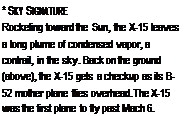
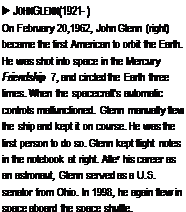
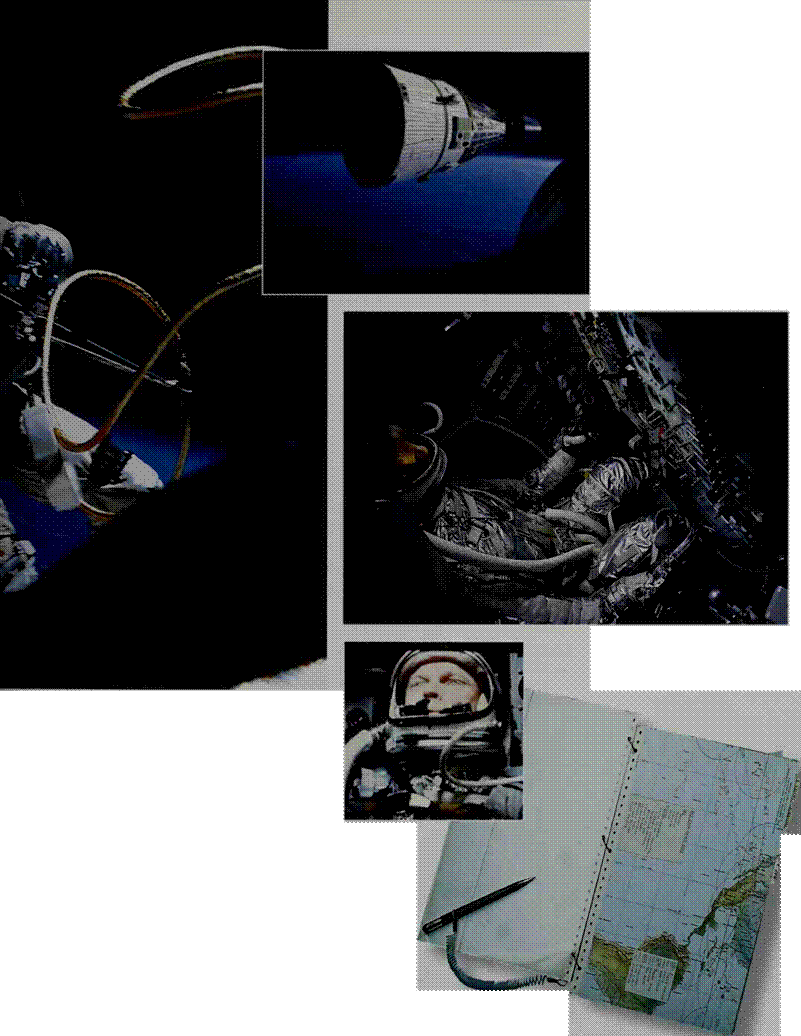


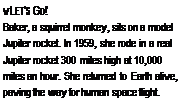
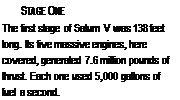
 HREE, two, one—we have liftoff!” With these words, rocket engines explode with a deafening roar, spewing out columns of fire and gas. Smoke billows into the sky and the ground shakes as the mighty engines thrust the rocket into the sky and send it hurtling toward space.
HREE, two, one—we have liftoff!” With these words, rocket engines explode with a deafening roar, spewing out columns of fire and gas. Smoke billows into the sky and the ground shakes as the mighty engines thrust the rocket into the sky and send it hurtling toward space.





 The Moon’s gravity is one-sixth that of Earth’s. This allowed the astronauts on the Moon to jump high easily. If you jumped lightly on the Moon, it would feel like bouncing on a trampoline.
The Moon’s gravity is one-sixth that of Earth’s. This allowed the astronauts on the Moon to jump high easily. If you jumped lightly on the Moon, it would feel like bouncing on a trampoline.
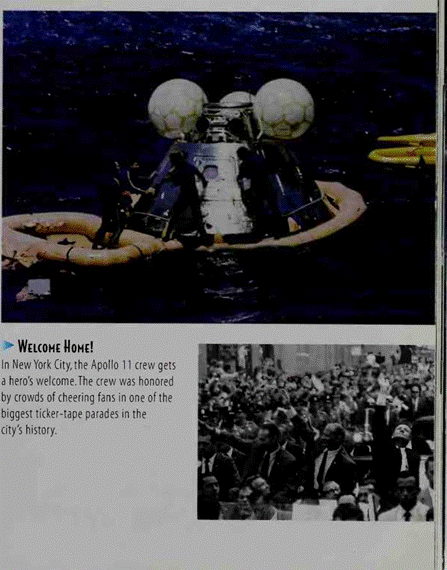
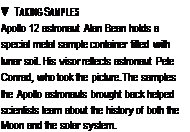
 The Lunar Rover was made of lightweight metal, mainly aluminum. It hail wire mesh tires to grip the dusty lunar surface. The battery- powered car had a TV camera, umbrella-shaped antenna, and tool rack. lt could travel 7 miles an hour. In it, the astronauts explored many miles from base.
The Lunar Rover was made of lightweight metal, mainly aluminum. It hail wire mesh tires to grip the dusty lunar surface. The battery- powered car had a TV camera, umbrella-shaped antenna, and tool rack. lt could travel 7 miles an hour. In it, the astronauts explored many miles from base.





 A total ol 12 men landed on the Moon. They gathered a vast store of knowledge. From rock and soil samples, scientists learned about the Moon’s formation, history, and chemistry. They discovered that iMoon minerals are similar to Earth’s but many have heavier iron and titanium content. They found the Moon has a very thin atmosphere of helium, hydrogen, argon, and neon. They also found that the Moon has a magnetic. field.
A total ol 12 men landed on the Moon. They gathered a vast store of knowledge. From rock and soil samples, scientists learned about the Moon’s formation, history, and chemistry. They discovered that iMoon minerals are similar to Earth’s but many have heavier iron and titanium content. They found the Moon has a very thin atmosphere of helium, hydrogen, argon, and neon. They also found that the Moon has a magnetic. field.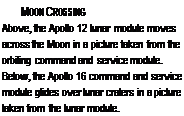

 Fun Fact: Long Way From Home
Fun Fact: Long Way From Home






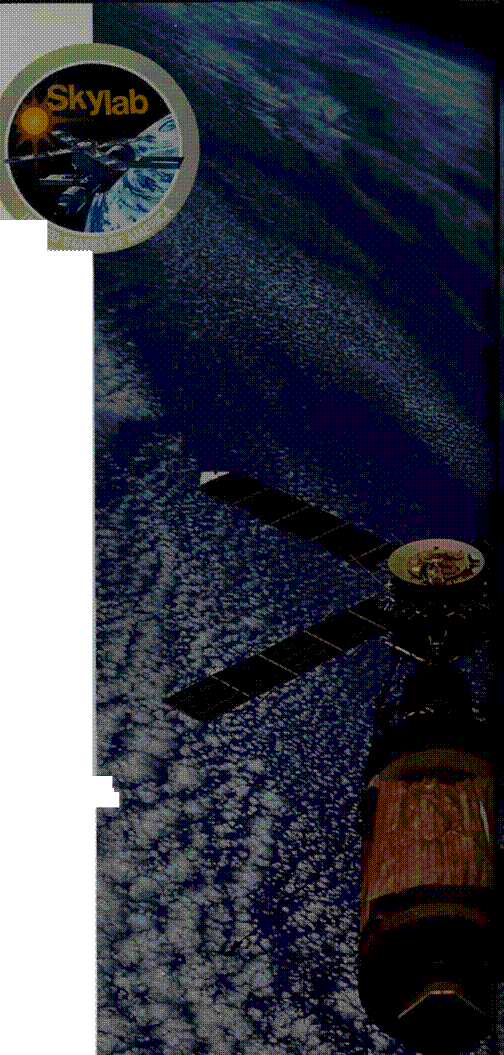 Dinner is Served
Dinner is Served

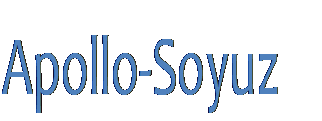
 N the 1970s, the United States and the Soviet Union began a new period of cooperation. They even agreed to launch a joint space mission, called the Apollo-Soyuz Test Project. In July 19/5, two manned spacecraft took off. One was an American Apollo capsule launched from Florida. The other, a Soyuz capsule, was launched Irom Kazakhstan in the Soviet Union. On July 17, the two capsules met in Earth orbit and successfully docked. They used a specially designed docking module. It lit to the Apollo on one end and to the Soyuz on the other end.
N the 1970s, the United States and the Soviet Union began a new period of cooperation. They even agreed to launch a joint space mission, called the Apollo-Soyuz Test Project. In July 19/5, two manned spacecraft took off. One was an American Apollo capsule launched from Florida. The other, a Soyuz capsule, was launched Irom Kazakhstan in the Soviet Union. On July 17, the two capsules met in Earth orbit and successfully docked. They used a specially designed docking module. It lit to the Apollo on one end and to the Soyuz on the other end.


 * Touch the Moon
* Touch the Moon
 from the Museum’s ceiling is the Bell X-l, a bright orange, bullet-shaped plane equipped with a rocket engine. In 1947 an American test pilot named Chuck Yeager accelerated it to 700 miles per hour to break the sound barrier for the first time.
from the Museum’s ceiling is the Bell X-l, a bright orange, bullet-shaped plane equipped with a rocket engine. In 1947 an American test pilot named Chuck Yeager accelerated it to 700 miles per hour to break the sound barrier for the first time.






 BALLOONING was popular in the 1800s. And with gliders, people could actually soar on wings like birds. Yet balloons and gliders were hard to control. They drifted with the wind. Inventors now began trying to achieve powered, controlled flight.
BALLOONING was popular in the 1800s. And with gliders, people could actually soar on wings like birds. Yet balloons and gliders were hard to control. They drifted with the wind. Inventors now began trying to achieve powered, controlled flight.
 ► Samuel PierpontLangley (1831,-1906)
► Samuel PierpontLangley (1831,-1906)





 —Orville Wright, 1903
—Orville Wright, 1903


 The Wrights were the first to realize an airplane propeller is really a small, twisted wing that rotates. They designed propellers of carved wood.
The Wrights were the first to realize an airplane propeller is really a small, twisted wing that rotates. They designed propellers of carved wood.
 He brought the toy from Paris for the son of friend Frank Coffyn.
He brought the toy from Paris for the son of friend Frank Coffyn.


